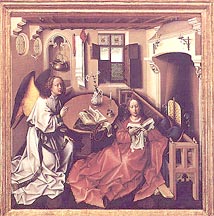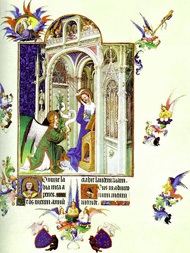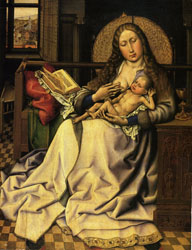Art Web | Arth
Home | Arth Courses | Arth
110 |ARTH
110 Assignments | Forward | Back
| Contact
ARTH 110
FLEMISH ART: ROBERT CAMPIN, JAN VAN EYCK, AND ROGIER
VAN DER WEYDEN
SLIDE LIST 3



|

|
|
| Robert Campin (Master of Flémalle),
documented in Tournai from 1406, died in 1444, Mérode
Altarpiece, c. 1425-28. |
The Limbourg Brothers, The Annunciation
to the Virgin from the Très riches heures, c. 1413-1416. |
|
|

|
|
| Detail of the Central panel with the table |
Majolica Vase, Florence, c. 1430. |
Detail of the right panel of the Mérode
Altarpiece: Joseph in the Carpenter Shop. |

|

|
| Jan Van Eyck, c. 1370/90-1441, "valet
de chambre" of Philip the Good, Duke of Burgundy, The
Rolin Madonna, (Chancellor Nicholas Rolin), c. 1435. |
Robert Campin, The Madonna of the Firescreen.,
c. 1430. |

|

|
| Detail of the Madonna of the Firescreen. |
Details of the Rolin Madonna. |

|
  

|
| Jan Van Eyck, The Arnolfini Wedding
Portrait (Giovanni Arnolfini, merchant from Lucca, and Giovanna
Cenami), 1434. |
Details from the Arnolfini Wedding Portrait. |

|

|
| Jan Van Eyck, Rolin Madonna, c.
1435. |
Rogier van der Weyden, St. Luke Drawing
the Virgin, c. 1435-40. |
|
|

|
|
| Rogier van der Weyden, Deposition, c. 1435. (for other Rogier images) |
|
TERMS
Oil painting-
Although Jan Van Eyck is traditionally credited with the invention
of oil painting, pigments mixed with drying oils (linseed, walnut,
etc.) were used long before the fifteenth century for special
purposes such as painting on stone or metal. Van Eyck, however,
was among the first to use the medium for panel painting. With
oils, which are far more flexible than the traditional tempera,
artists could create illusionistic effects of extraordinary subtlety,
richness, and luminosity. Oils permitted the smooth blending of
colors, high saturation, the use of transparent glazes, almost
infinite detail, and of the possibility of reworking the same
area over and over again. Other capabilities of oil painting were
realized in the sixteenth and seventeenth centuries, when it was
roughly applied to the canvas in opaque "scumbles" and
thick "impastos."
Altarpiece: a painted or sculptured panel or shrine placed
behind and above an altar. Fourteenth- and fifteenth century altarpieces
are often very complicated, consisting of several panels or separate
groups of sculpture. An altarpiece consisting of two panels is
called a diptych; one with three panels is a triptych;
when it has more than three panels it is called a "polyptych."
Some altarpieces have a decorated base, or "predella,"
and have shutters or wings which can be opened.
LINKS
For more images of the works of Robert Campin,
Jan Van Eyck, and Rogier Van der Weyden see the following useful
sites:
Early Netherlandish Painting
Robert Campin (Master of Flémalle):
Robert Campin, The Mérode Altarpiece.
WebMuseum: Flémalle, Master of (Robert Campin)
Mark Harden: Robert Campin
Jan Van Eyck:
Mark
Harden: Jan Van Eyck
Carol Gerten Jackson: Jan van Eyck
WebMuseum: Jan Van Eyck
Rogier Van der Weyden:
Mark Harden: Rogier van der Weyden
WebMuseum: Rogier van der Weyden
Carol
Gerten Jackson: Rogier van der Weyden
See also the following web pages I have developed for my Nothern Renaissance
Art class: Robert Campin , Jan
Van Eyck as Court Artist, Arnolfini
Wedding Portrait, Works
of Jan Van Eyck.
Maps

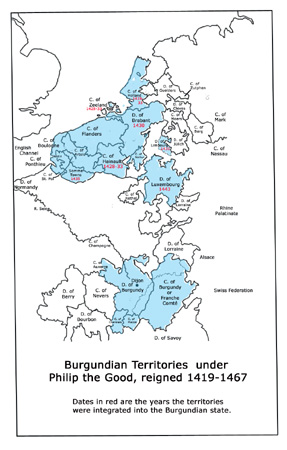
QUESTIONS FOR REVIEW
| Robert Campin (Master of Flémalle),
Mérode Altarpiece, c. 1425-28 |
The Limbourg Brothers, The Annunciation
to the Virgin from the Très riches heures, c. 1413-16 |
Compare and contrast these two works. Note
the different social contexts in which the works were produced.
Demonstrate how these have led to these different visualizations
of this same subject matter.
|
Jan Van Eyck, The Rolin Madonna, c. 1435. |
Robert Campin, The Madonna of the Firescreen,
c. 1430. |
Both of these works are major monuments
of the "new" style developed in Flemish or Netherlandish
art during the second quarter of the fifteenth century. Note the
different social contexts in which the artists worked, and how
these led to these different representations.
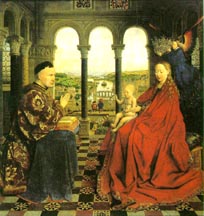
|
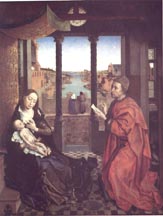
|
| Jan Van Eyck, The Rolin Madonna, c. 1435. |
Rogier van der Weyden, Saint Luke Drawing
the Virgin, c. 1435-40. |
Very evidently Rogier based the composition of his work on Van
Eyck's Rolin Madonna, but at the same time we can see how he has
established a very different point of view in his work. Articulate
the different points of view the artists present in these works.
Additional Images
Jan Van Eyck, Madonna and Child and the
Canon George van der Paele , c. 1437.
Art Web | Arth
Home | Arth Courses | Arth
110 |ARTH
110 Assignments | Forward | Back
| Contact




















